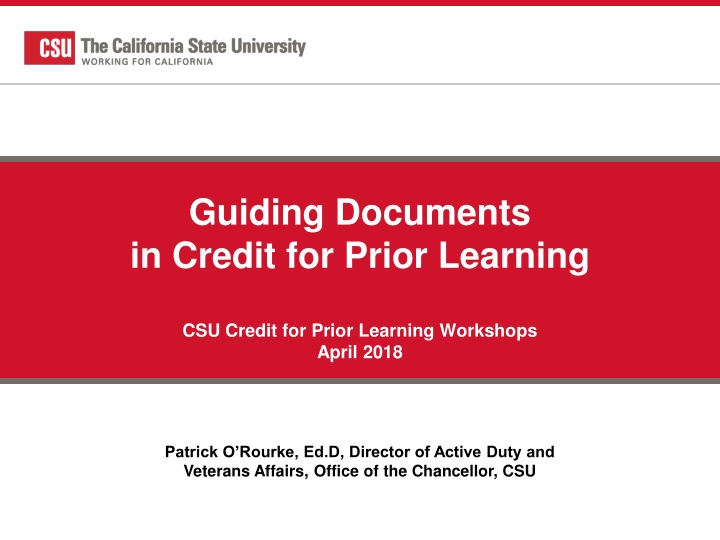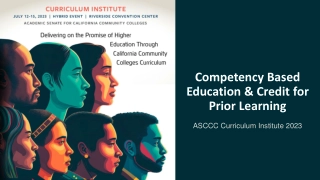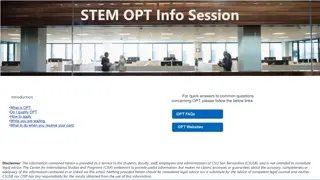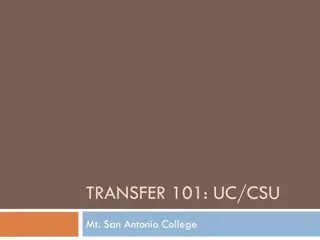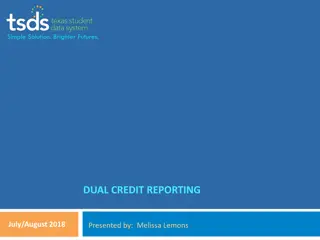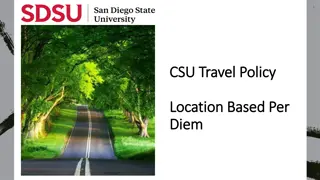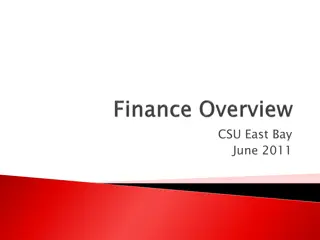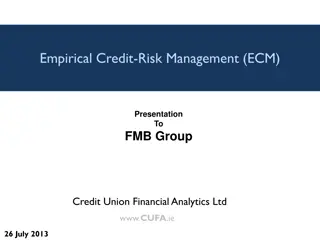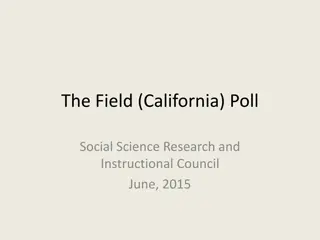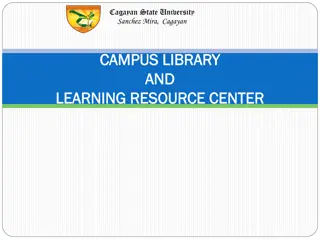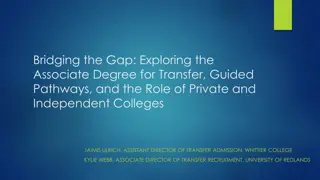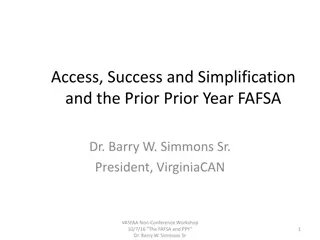CSU Credit for Prior Learning Workshop Insights
Explore the guiding documents influencing CSU's credit for prior learning processes, review survey results, and learn about military credit evaluation methods. Discover how CSU campuses assess academic credit for military training and the familiarity levels among staff and faculty in this insightful workshop overview.
Download Presentation

Please find below an Image/Link to download the presentation.
The content on the website is provided AS IS for your information and personal use only. It may not be sold, licensed, or shared on other websites without obtaining consent from the author.If you encounter any issues during the download, it is possible that the publisher has removed the file from their server.
You are allowed to download the files provided on this website for personal or commercial use, subject to the condition that they are used lawfully. All files are the property of their respective owners.
The content on the website is provided AS IS for your information and personal use only. It may not be sold, licensed, or shared on other websites without obtaining consent from the author.
E N D
Presentation Transcript
Guiding Documents in Credit for Prior Learning CSU Credit for Prior Learning Workshops April 2018 Patrick O Rourke, Ed.D, Director of Active Duty and Veterans Affairs, Office of the Chancellor, CSU
Learning Outcomes Be familiar with some of the documents that influence CSU credit for prior learning processes and procedures. Be exposed to survey information on the CSU s credit for prior learning processes. 2
Agenda 2016 CPL Survey Results; Veterans Inventory Survey Results WASC and the Joint Statement EO 1036 SB 1071 (proposed legislation) School Certifying Official Handbook A Guide to Best Practices: Awarding Transfer and Prior Learning Credit 3
Military Credit For Prior Learning Survey
2016 CPL Survey Overview September-October 2016 Target Audience: CSU Articulation Officers 20-question Survey Monkey survey Based on ACE s Credit for Prior Learning Tool Development/Pilot Involved: Articulation officers, transfer and GE specialists, and others 100% response rate 5
Credit for Prior Learning Methods Method Campuses All All All 19 CLEP Testing International Baccalaureate AP Testing DSST Credit by Exam 6 Excelsior College Examination Program 22 6 9 12 3 20 22 ACE Military Credit Recommendations ACE Corporate/Workplace Credit Recommendations Institutional Challenge Exams Departmental Challenge Exams Student Portfolios Articulation agreements with community colleges DD 214 6
Results 22 CSU campuses use both ACE and the DD214 (Department of Defense [DOD]discharge form) to assign academic credit for military training. 6 out of 23 (26%) campuses report seldom using military CPL policies; 2 of the 6 have not established military CPL policies. 65% of the respondents reported that staff were either very familiar or familiar with assigning academic credit for military training. 100% of the respondents (articulation officers) reported that faculty were either not familiar (48%) or somewhat familiar (52%) with assigning academic credit for military training. 7
Results 87% responded that they would benefit from military CPL training. 26% (6) of the campuses reported not accepting pass along JST credit for GE credit assigned at a community college. 39% (9) of the campus reported not accepting pass along JST credit for elective credit assigned at a community college. 44% (10) reported not accepting pass along JST credit for major coursecredit assigned at a community college. 8
Results: Challenges Military prior learning does not match major discipline fields Most military credit is issued an elective Units are received but not specific course credit Some military transfer credits are deducted to avoid exceeding 150 units (Satisfactory Academic Progress) Some military or veteran students do not submit their Joint Service Transcripts (JSTs) or submit them late in their term 9
Results: Challenges There are many military occupations to research and a variety of credit in these areas ACE credit recommendations are very general making it difficult for the campus to assign major discipline credit 10
Results: Recommendations Create military career-related degree plans throughout the CSU CO should provide guidelines for campuses to follow. Training and a dedicated website for evaluators, faculty, and articulation officers. Post a list (similar to AP, IB, and CLEP) of military course recommendations for GE so all may know. Military prior learning does not match major discipline fields. 11
Credit for Non-collegiate Education Who should attend the training? Attendees No Response Faculty and Evaluation Staff Just Evaluation Staff 3, 13% 7, 30% 3, 13% Veterans and Evaluation Staff Faculty, Veterans, Eval Staff (all) 5, 22% 5, 22% **43% believe faculty involvement is important
Credit for Non-collegiate Education How do you assign credit without coursework? Sources for Assigning Credit 2, 7% American Council on Education DD 214 3, 10% 2, 7% 13, 45% Joint Service Transcript We Do Not Assign Credit Unknown 9, 31%
Credit for Non-collegiate Education Campus CPL policies are Description of CPL Policies Seldom Used 4, 8% 14, 28% Up-to-Date Easy to Understand 11, 22% Difficult to Understand Out-of-Date 14, 28% Not Established 2, 4% Frequently Used 4, 8% 1, 2%
Western Association of Schools and Colleges (WASC)
WASC Joint Statement (ACE-CHEA-AACRAO) WASC Joint Statement Encourages use of Extra- institutional recommendations (transfer of credit policy) Institution-based assessment policy letter >25% of degree Must link to existing institutional course(s) Evidence of learning Clear standards and criteria Credit is awarded by faculty Matriculated students only No advanced assurances No duplicating credit Transparency Extra-institutional credit transfer Inter-institutional credit transfer Educational quality Nature, content, level of learning Institutional autonomy & responsibility Need for well-articulated policies Comparability Use of learning outcomes and experiences Use of valid evaluation measures Decisions not made solely on source of accreditation Transparency and consistency 16
EO 1036 Dated 14 July 2008 Three articles Article 1: Credit for Examination Article 2: Credit for Demonstrated Learning, Knowledge or Skills from Experience Article 3: Credit for Formal Instruction in a Non- collegiate Setting 18
EO 1036 Article 1 Campus-originated Challenge Exams Applicable for admissions and degree Campuses shall develop procedures Policies and procedure on website and catalog Standardized External Exams (CLEP, AP, DSST, IB) Can be applied to GE Breadth for transfer students Except IB and AP, credits are limited to 30 semester units 19
EO 1036 Article 2 Authority Campuses have discretion how to award credit Credit for experience shall not be used to determine eligibility for admissions Conditions Student must be matriculated Must service academic objectives the institution and student Awarded credit must be academically credible 20
EO 1036 Article 2 Conditions, cont d. Student must complete sufficient number of units to establish satisfactory learning pattern IAW campus procedures Verification and Evaluation (campus policy) Portfolios, interviews, demonstration, exam Application for Credit (campus discretion) Documentation Descriptive and identifiable in student record Transparent in catalog and website 21
EO 1036 Article 3 Types of Instruction Approved for Credit Formal instruction as recommended by ACE Either military or civilian Lower division degree credit comparable to the CSU Upper division degree credit Graduate degree credit 22
EO 1036 Article 3 Application of Credit Campuses shall allow the number of units recommended by ACE Efforts shall be made to award major or GE credit as opposed to just elective credit Campuses are encourage to offer 3 units of GE Area E for completion of basic training No credit for health courses for teaching credential 23
EO 1036 Article 3 Conditions of Award (refers to Article 1) Standard throughout the system (?) Not awarded for previous equivalent credit Must be awarded at the same level as the recommended credit Must not duplicate credit Documentation Joint Service Transcripts (appropriate term); DD 214; DD 295; Community College of the AF; etc. Policy/procedures posted on website and catalog 24
Senate Bill 1071 (proposed legislation)
SB 1071 (Proposed Legislation by Senator Newman) 1. CCC will develop a uniform policy among its institutions and districts that provides for the awarding of academic credit for military service, education, and training. 2. This uniform policy will align with other public post-secondary education systems. 3. This policy will include general education course credit within California Intersegmental GE Transfer Curriculum and the CSU GE Breadth. 4. If the CCC fails to implement the policy by fall of 2019, it will present reasons for failure to a legislative body responsible for such actions and be given an extension until the fall of 2020 academic term to implement said policy. 26
SB 1071 (Proposed Legislation by Senator Newman) 5. The uniform policy will be posted on institutional websites. 6. The authority and responsibility of this uniform policy is directed at the CCC Chancellor and the academic senate. 7. The legislation asks to consider using Joint Service Transcripts and ACE recommendations. 8. The policy will be periodically reviewed and updated. 9. Costs, if determined, are pursuant to statutory provisions. 27
School Certifying Official Handbook
School Certifying Official Handbook PRIOR CREDIT Found in Title 38,Code of Federal Regulations, Sections 21.4253(d)(3) and 21.4254(C)(4). This requires every approved school to have and enforce a policy with regard to transfer courses, credits, and previous experience. Reviews of prior credit policies will be conducted during compliance surveys and treated as approval issues if the school is not complying. However, if a transcript cannot be obtained, you may continue to certify enrollment as long as the student has matriculated (see definition of non- matriculated students). 29
A Guide to Best Practices: Awarding Transfer and Prior Learning Credit (A Framework for CPL)
Learning Outcome Utilize a proposed framework for building effective policies and procedures for awarding transfer and prior learning credit. 31
Definitions Do we need definitions? Pass along credit? What is an official transcript? What is Prior Learning Assessment? What constitutes college-level coursework? 32
Course Equivalencies Credit Conversion Recommended Practice*: Multiply 4 quarter hours by .67% to get semester hours Multiply 2.68 semesters hours to reverse the equation Grades Best Practice: Grade of C or better for transfer Statement on remedial coursework ID minimum grade for pass Credit Limits (2- and 4-year institutions) How many credits are accepted? Recommended practice: Identify minimum credits and maximum credits 33 *Comments in blue are highlighted from Best Practices
Course Equivalencies Credit Levels Methods for articulating across levels Best practice: Transfer 100- and 200-level courses at the same level; articulate 200- to 300-level coursework when academic rigor is the same; transfer 300- to 400-level when possible. Non-transferability What credit will not be accepted and why? Special discipline transfer What rules govern what courses? (study abroad, ESOL, CTE) 34
Course Equivalencies International Transfer Credit What rules apply to international transfer credit Credit Life and Expiration How long should credit be valid for? In what cases might that change? Are durations the same for all disciplines (History vs. CAD [STEM]) Accreditation Parameters Are Nationally and Regionally accredited institutions treated the same? Applicability and Awarding of Credit Should there be rules for assigning types of credit? Should credit be awarded if it is detrimental to the student (SAP)? 35
Evaluating and Transcripting Credit Transcripting Credit How is coursework posted to the transcript? Is this described to students having their credit evaluated? Is this processed linked to change-of-major and re- evaluation-of-credit appeal processes? Internal Process for Evaluating Coursework Best Practice: Course equivalencies should be made by discipline faculty or designee Best Practice: Recommend using 70% matching of content to determine equivalency, unless otherwise needed for specific licensure or accreditation reasons 36
Evaluating and Transcripting Credit Internal Process for Evaluating Coursework Who is responsible for this procedure? What materials are needed? Post all equivalencies online. Best Practice: Course equivalencies should be made by discipline faculty or designee Best Practice: Recommend using 70% matching of content to determine equivalency, unless otherwise needed for specific licensure or accreditation reasons Best Practice: Review coursework every five years unless discipline requires more frequent reviews (computer science, etc.) Best Practice: Posting equivalencies on a common database for ease of access 37
Evaluating and Transcripting Credit Recognition of other forms of credit: ACE External Exams Articulation Agreements Experiential Learning How does this credit transfer? GE? Major Credit? Articulation Agreements Best Practice: Effective agreements indicate how many credits will transfer, what they will satisfy, and the process by which the credits will be applied. Post them on a website for all to find. 38
Institutional and Student Rights and Responsibilities State and Federal Rights and Requirements EO1036 Transfer Policies Student Appeal Process POC, documents, timeline Residency Requirement for Transfer What are institutional residency requirements? Limits? Post-transfer Matriculation/Reverse Transfer What are the rules for credit transfer after the matriculation? Course Transferability How do we ensure our courses are transferable? Student Expectations Disclosure and transparency 39
Resources WASC CPL Policy https://www.wscuc.org/content/credit-prior-learning-policy WASC Credit Transfer Policy https://www.wscuc.org/content/transfer-credit-policy EO 1036 https://calstate.edu/eo/EO-1036.html SB 1071 https://leginfo.legislature.ca.gov/faces/billTextClient.xhtml?bill_id=20172 0180SB1071 SCO Handbook (p.50) https://benefits.va.gov/GIBILL/docs/job_aids/SCO_Handbook.pdf 40
Resources ACE CHEA AACRAO Joint Statement http://www.acenet.edu/news-room/Documents/Joint-Statement-on-the- Transfer-and-Award-of-Credit.pdf A Guide to Best Practices: Awarding Transfer and Prior Learning Credit http://www.aacrao.org/docs/default-source/TrendTopic/Transfer/a- guide-to-best-practices-awarding-transfer-and-prior-learning-credit.pdf Troops to College Credit for Prior Learning Webpage https://www2.calstate.edu/attend/student-services/troops-to- college/applying-to-the-csu/Pages/credit-for-prior-learning.aspx 41
porourke@calstate.edu www.calstate.edu/veterans 42
Learning Outcomes Campus System Community 1. Discuss how you might improve the processes for articulating military education and experience for academic credit at your campus. How might the system be involved? The community? 2. Discuss what groups of people, resources/tools, and guidance are necessary to meet campus challenges. What system and community resources might be available to assist campuses? 3. Discuss how you personally might resolve some of the challenges faced in improving your credit for prior learning program. What three things can you action when you return to campus? 43
Summary of Learning & Future Actions What did we learn in the past day and a half? Epiphanies? Burning questions review 44
High-Impact Practices Provide transparency on website and in catalog Catalog and publish articulated courses and agreements for prospective transfer students Borrow best practices from others Solve the SAP-credit transfer conundrum Build a CPL team on campus Learn how best to integrate faculty into the process 45
